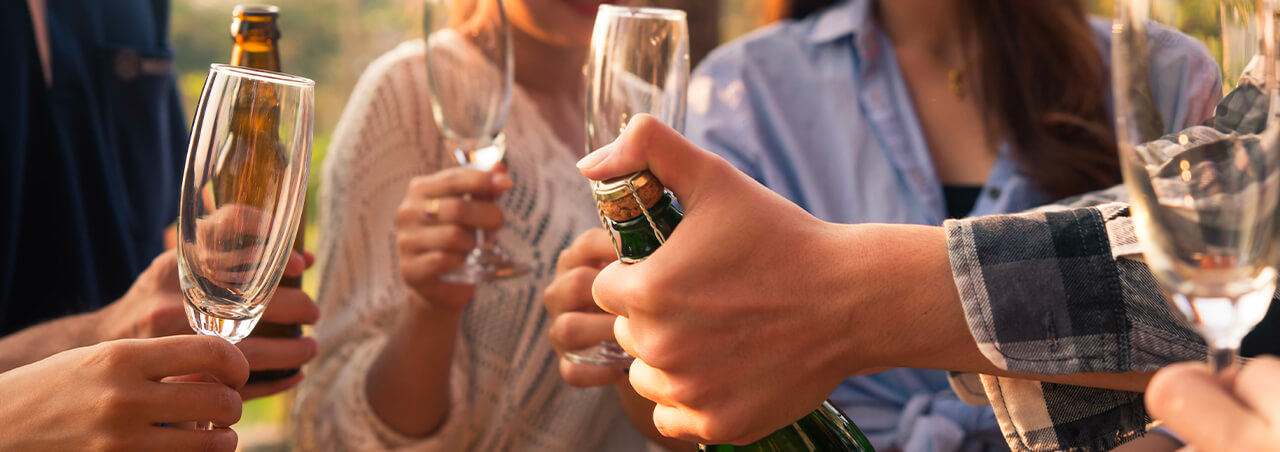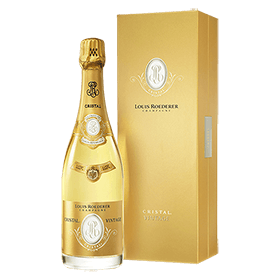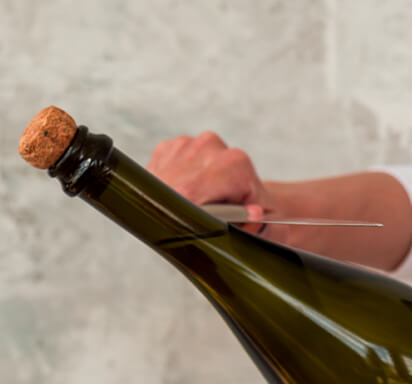Learn how to open a Champagne bottle now!

To help you safely open a bottle of bubbly, we have put together a guide with 6 simple steps. Learn more about when to open a bottle of Champagne and how to do it in the safest and most graceful way.
We’ve all heard the horror stories of a loose Champagne cork flying across the room and taking out a guest’s eye or shattering a precious ornament. Holding back 90 psi of pressure (Think of this as three times the pressure of an average car tire!), an ill-aimed cork has some potential for destruction. To help you safely open a bottle of bubbly, we have put together a guide with 6 simple steps. Learn more about when to open a bottle of Champagne and how to do it in the safest and most graceful way.
WHEN TO OPEN A BOTTLE OF CHAMPAGNE
Before getting into how to open a bottle of bubbles, it is important to consider timing. The shelf life of a Champagne will depend largely on the style in which it was made and the conditions in which it has been stored.
For example, vintage champagne will typically last longer, whereas non-vintage champagnes will usually have a shorter shelf-life. This is because vintage champagne grapes often come from the best plots of a property and create riper, more concentrated wines. There are several exceptions to this generalization: several non-vintage champagnes show equally impressive aging potential. As a rule of thumb, however, it is advisable to keep a bottle of vintage champagne in the cellar for 10+ years.
Then, there is the question of proper storage. Even a pricy bottle of a best year’s vintage champagne can go bad if stored under subpar conditions. For long-term storage of an unopened bottle of Champagne we recommend finding a cool, dry place. To learn more about how to store an unopened or opened bottle of Champagne, check out our “How to store Champagne” article! In it you will also learn the best way to handle an opened champagne bottle to keep the bubbles fizzy for longer.
You may be asking yourself, “Does Champagne expire? Does champagne go bad? Does champagne unopened lose its bubbles? How can I recognize a bad champagne, and is it hamrful to drink bad champagne?” For the answer to all these questions, take a look at our “How long does Champagne last?” article!
BEFORE YOU OPEN A BOTTLE OF CHAMPAGNE OR SPARKLING WINE
So you have made the decision to open your bottle of sparkling wine or Champagne. Great! A bottle of bubbly is an excellent choice to celebrate a special occasion but will also add a dash of glamor and joy to pretty much any moment you choose. We have a few tips to consider before opening your bottle.
• Make sure to chill the bottle. Before opening your bottle of Champagne, we recommend chilling it to around 45 degrees Fahrenheit. Like most other sparkling wines, Champagne is meant to be consumed on the cool side, but there is another reason to do this: If your bottle is not cold enough, the pressure inside will cause the cork to release very quickly and this can be dangerous. Chill your bottle gradually in a refrigerator or in a bucket of ice water.
• Pat the Champagne bottle dry. Especially if you are chilling your bottle in ice water, it is important to wipe it down before attempting to open it. A wet bottle can become quite slippery and you may end up dropping it. Drying the bottle of a good champagne also protects the label from disintegrating and allows your guests to see valuable information, like the champagne vintage and name of the cuvée.
HOW TO SAFELY OPEN A CHAMPAGNE BOTTLE IN 6 SIMPLE STEPS
One you have your cool, dry bottle of Champagne ready to open, you can follow these simple steps. For a very old champagne unopened vintage, do not hesitate to contact our team directly and we will walk you through how to safely open it.
1. Remove the foil.
The first step in opening a Champagne bottle is to remove the foil wrapped around the neck of the bottle. In the case of most champagnes, the foil will have a small tab to pull for easy removal. If this fails or if no tab is present, use a wine key or knife to cut the foil evenly off below the bottle’s large lip. This creates a clean, even line around the bottle and exposes the wire cage for Step 2.
2. Remove the metal wire cage
Hold the Champagne bottle at a 45° angle, pointed away from yourself. Use a towel or napkin to hold the top of the wire cage down against the cork as you untwist the tab of the wire cage (6 half-twists, counterclockwise). Loosen the cage around the bottle and remove it only when you are ready to open the bottle. This wire cage, known as a muselet in French, is there to protect the cork until the bottle is ready to be opened.
3. Secure your hand over the cork
Continue holding your bottle at a 45° angle away from yourself. Secure your non-dominant hand (so, your left hand if you are right-handed and your right hand if you’re a leftie) over the top of the bottle, with your thumb over the top of the cork and the rest of your fingers around the neck of the bottle. Your dominant hand should be around the base of the bottle to allow for greater control over the later. This part can be a little tricky, especially when opening a large format bottling, such as the 3-liter Jeroboam Champagne bottle.
4. Twist the bottle, not the cork
To remove the cork, make sure to rotate the bottle and not the cork. Twisting the cork, especially in the case of an older bottle, can break the latter, resulting in pieces of cork in your Champagne.
5. Guide the cork out with a hiss, not a pop
Once the bottle has loosened around the cork, you may feel the cork begin to move on its own, pushed out by the pressure in the bottle. With your thumb, push gently against the cork to keep it from popping out too quickly. Lift you thumb slowly to guide the cork gradually out, so that it is released with a “hiss” sound, rather than a “pop.”
6. Wipe the lip of the bottle and serve
Before serving your bottle of Champagne, give the lip of the bottle a quick wipe to get rid of any excess foam that may have spilled out. To serve, tilt the bottle at an angle over a glass of champagne, making sure not to touch the rim of the glass with the bottle. To serve, pour an inch of the liquid into a glass and wait a few seconds for the bubbles to reduce before filling the rest of the glass. The standard Champagne pour is 4 ounces, or 2/3 of the glass.
And there you have it, your bottle of Champagne open, served and ready to be enjoyed! For any questions about the above-mentioned steps, do not hesitate to contact our team directly.
SOME ADDITIONAL DOS AND DON’TS
Ready to practice opening a bottle of sparkling wine or Champagne? Perfect! But first, here are a few more dos and don’ts when opening a bottle of bubbly.
• DO chill your bottle before opening it. At room temperature, the carbon dioxide pressure builds up inside of the bottle, pushing the cork out more quickly before you are ready to open it. Chilling the bottle lowers the pressure, allowing you more control over the process. DO chill your bottle gradually in a refrigerator or bucket filled with 50% ice and 50% water. DO NOT chill your bottle suddenly in the freezer, where it can explode and leave a mess.
• DO NOT, under any condition, shake your bottle of Champagne before opening it. When removing it from the ice bucket or fridge, make sure to do so gently. Otherwise the pressure inside the bottle can unleash the cork by force and cause damage to your surroundings. If you do end up accidentally shaking your bottle, set it aside in a cold place for an hour or so to allow the carbon dioxide to settle back into the liquid.
• DO use a napkin or a kitchen towel wrapped around the bottle to steady your grip while you are releasing the cork. This will prevent the bottle from slipping from your hand and will give you more control over the removal of the cork.
• DO NOT pour the Champagne too quickly. As Champagne is a carbonated beverage, the bubbles can push the liquid to the top of the glass quickly, leading to a spill. In order to prevent wasting Champagne, pour it slowly into upright glasses, filling the latter up to only about an inch. Wait for the bubbles to reduce down slowly before filling the glass completely.
• DO, in the case of an older vintage, pour yourself a small sample of the Champagne to smell and taste before serving others. Make sure the Champagne has no off-aromas (wet cardboard, nail polish or mushroom juice) and no rancid, sour taste before serving others. If the Champagne has gone bad, discard the bottle directly.
SOME FUN ALTERNATIVE WAYS TO OPEN A CHAMPAGNE BOTTLE
Our simple 6 step guide for opening a bottle of Champagne describes the way to open a bottle in 99% of social settings. It is often said that Champagne should open with a hiss or a sigh, rather than a pop. Nevertheless, certain rare situations call for a showier, more dramatic Champagne bottle opening. Discover these alternative ways to open a bottle of Champagne with a bit more flare.
• The Champagne Rocket Launch: Add a bit of drama to your New Year’s Eve or birthday celebration by launching the cork like a rocket into the sky. To do so, follow our guide all the way up until Step 5. Then, instead of guiding the cork out gently once it is loosened, hold it back with your thumb and then let go, allowing it to fly out over the heads of your guests. Make sure to aim the bottle away from your guests or anything fragile to avoid damage.
This method of opening a bottle will lead to a festive “pop!” sound, a cork launched into the sky, and the Champagne bursting out of the glass in a shower due to the built up pressure in the bottle. While it does make for quite the spectacle, we do not recommend this method with a very nice bottle of Champagne, as it involves significant spillage and waste.
• The Champagne Saber: An entertaining and ceremonial yet quite dangerous way to open a Champagne bottle is by sabering it. This involves using the blunt end of a saber, sword or large knife to strike the Champagne bottle along the seam, causing the glass to split and the top half of the bottle neck to be removed in one swift swoop.
When done correctly, there are no shards of glass and the champagne can be served directly from the neck of the bottle. When done incorrectly, the broken shards of glass can damage the person sabering the bottle and can also fall into the wine. Take a look at our article about the Champagne Saber to learn more about this technique!
Now that you know how to open a bottle of Champagne, maybe you are asking yourself “Where can I find champagnes near me?” Browse our extensive selection of top Champagne brands directly on our site or reach out to our team directly with any questions you may have. We’d be delighted to guide you through our selection and help you choose the right bottle for your occasion.
You may like
Unveil the unique characteristics of Champagne Blanc de Blancs and Blanc de Noirs. Learn how these two styles differ in flavor, grape varieties, and food pairings to elevate your Champagne experience.
12/19/2024Discover how Chardonnay, Pinot Noir, and Pinot Meunier shape the distinct character of Champagne. Learn about rare grape varieties and explore notable examples from top producers in the world’s most famous sparkling wine region.
7/4/2024A swift swoop of the knife along the neck of the bottle, followed by a “pop!” as the glass shatters and the “hiss” of the Champagne as it flows out. There is no more festive way of opening a bottle of Champagne than by sabering it
3/8/2023Guardian of the bottle and the precious bubbly inside, the cork serves an essential role in the preservation of Champagne. Over the years, it has evolved and adapted to this very special role.
3/6/2023What is the best way to store Champagne or sparkling wine for the short or long term? Find here best storage practices, which will help keep your bottle of bubbly Champagne or sparkling wines fresh for as long as possible.
2/20/2023Seeking a bottle of champagne for a special occasion but not sure which style to choose? We hear you. Champagne is one of the most complex styles of wine, available in a wide range of colors and at many different sweetness levels.
2/20/2023
















